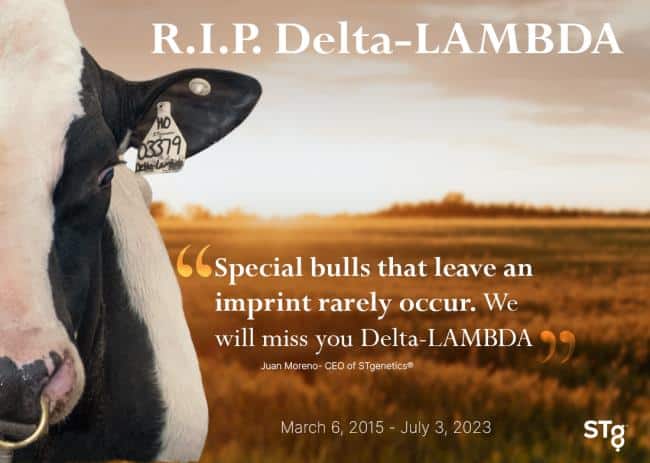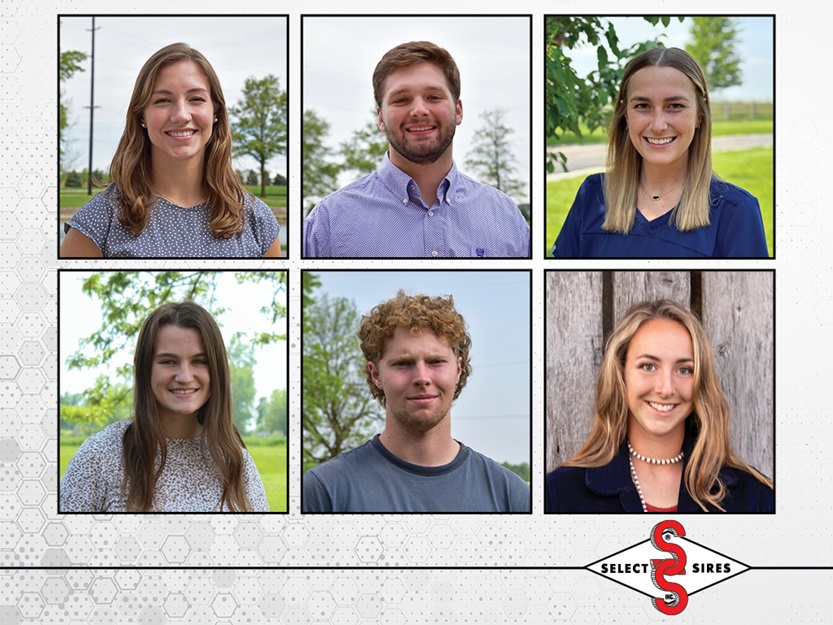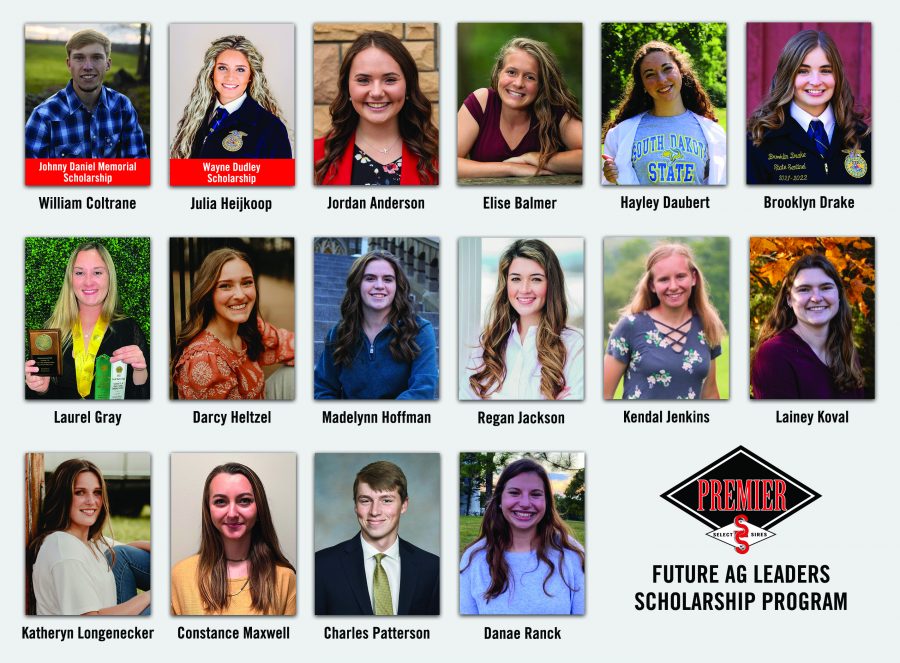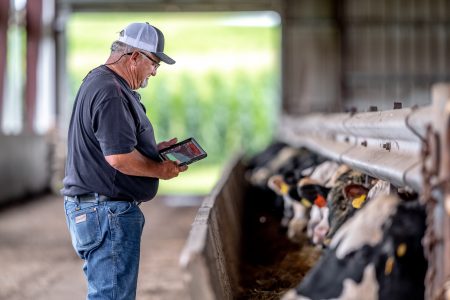The December proof run reaffirms the confidence of farmers in CRV’s breeding programme. In recent months, several bulls added daughter information to their proofs which confirms their popularity as young InSire bulls. Based on their daughters’ excellent performance, these bulls will now be re-included in CRV’s line up.
The introduction of the one-step model as an improvement of the breeding value estimation significantly increased the reliability of genomic breeding values at this proof run. This means that farmers can use the top InSire bulls from CRV’s breeding programme with even more confidence to improve their herds.
Wingstar scores on feed efficiency
For the first time, the red-and-white Delta Wingstar received a breeding value based on the performances of more than 400 daughters. With +0.28% fat and +0.28% protein, they confirm their sire’s qualities as a component sire. Wingstar’s breeding value for productive life rises to +785 days, he has a good all-round score for health traits and improves his conformation traits to 110 total score with 109 for feet and legs.
Wingstar fits into CRV’s FeedExcel breeding strategy for developing a herd that produces higher milk yields, requires less feed, achieves higher profitability and lower emissions. Since the introduction of FeedExcel, there has been rapidly growing interest in breeding for feed efficiency. A large number of farmers have started genomic testing their herd with HerdOptimizer, included FeedExcel into the mating programme SireMatch, by putting more emphasis on feed efficiency, health and longevity in their breeding goals and started selecting FeedExcel certified bulls.
Sunburst and Borax breed functional and efficient cows
The red-and-white daughter proven bulls in CRV’s line-up definitely add value to the red and white holstein population but also the black-and-white population. And that is also certainly true for a number of young InSire bulls.
The highest red-and-white InSire bull for NVI is Delta Borax. His high NVI score is on account of (among other things) more than 1,500 kg of milk with +0.31% fat, +859 days productive life, 107 total conformation with 108 udder and 106 feet and legs and 111 udder health. The Poppe Freestyle son has a breeding value for feed efficiency of 110, making him a FeedExcel bull par excellence. In Germany, Borax total index of 162 RZG, makes him the number one in the ranking of red-and-white bulls. In Germany, Borax scores 128 for feet and legs.
InSire bull Delta Sunburst is also a FeedExcel bull. His pedigree goes back to the Skalsumer Pietjes, the exact same cow family of which Sunny Boy was also born from. Sunburst sires more than 1,500 kg of milk with positive components, resulting in 168 kg of fat and protein and almost 500 Euros Inet in combination with 113 feet and legs and 111 total score.
Seducer with 112 hoof health, Sparkle with 116 feet and legs
InSire bull Delta Seducer P, from the well-known Caudumer Lol cow family and hence closely related to Delta Launch PP, has an appealing breeding pattern with very high components (+0.71% fat and +0.38% protein), 109 feet and legs and 108 total conformation. This calving ease sire fits into the FeedExcel breeding strategy and also scores well for daughter fertility (104) and excels on hoof health (112).
The new InSire bull Delta Sparkle (Powerlift x Jacuzzi) is a downright asset for the red-and-white holstein population, with an all-round breeding profile with more than 1,000 kg of milk with +0.43% fat and +0.12% protein, positive proofs for health traits and 113 total conformation, with as much as 116 for feet and legs.
CRV distinctive with PP
This proof run, the homozygous polled InSire bull Delta Primetime PP (Taskforce P x Abundant P) improved his breeding value for milk production. He went up by 2 points for feet and legs, to 112, and also two points for total conformation, to an absolute top score of 115. Primetime is exclusively available through the Create programme.
Primetime PP is a flagship of CRV’s successful breeding programme for polledness. This program results, among other things, in two bulls in the top 10 red-and-white PP in Germany, such as the high component sire Delta Scrambler PP with 151 RZG. Three CRV bulls can be found in the German top 10 black-and-white PP, including Delta Volkmar PP (149 RZG) and Delta Tycho PP (148 RZG).
Woody breeds efficient and high yielding cows
The black-and-white Willem’s-Hoeve Woody has managed to significantly improve his breeding values this index run; with an increase of 200 kg milk to +2,126 kg of milk (still having positive components) and +22 Euros Inet to 539 Euros Inet. His breeding value for feet and legs has improved by 3 points to 109 and he added 2 points to his breeding value total conformation to 112. He also gained in udder health (108) and hoof health (108). With a breeding value for feed efficiency of 109, the Ranger son is also a FeedExcel bull. With 152 RZG, Woody ranks at the fourth position in the ranking of daughter-tested bulls in Germany.
With Delta Universe P (Drone PP x Woody), CRV already has a polled and very interesting grandson of Woody on offer. He sires high production with more than 2,000 kg of milk with +0.25% fat and +0.20% protein, resulting in more than 200 kg of fat and protein. With a breeding value of 111 for feed efficiency, this FeedExcel bull surpasses his grandfather and with for 109 feet and legs and 106 udder health, he stands out for these sustainability traits. Universe P is already exclusively available through the Create programme.
FeedExcel bull Delta Glory (Perfect x Martin) is also a high-yielding bull with sires almost 2,000 kg of milk and positive components. In addition, this grandson of Midwolder Martin scores breeding values of 111 for feet and legs, 110 total conformation, 107 udder health and 109 hoof health. For persistency, Glory has a unique breeding value of 118.
Nobrainer makes a leap forward
Delta Nobrainer has made a significant leap forward in his breeding values. He shows an all-round profile at a very high level with (among other things) +0.78% fat and +0.22% protein, 110 udder health and 107 hoof health and +840 days productive life. Nobrainer is also a FeedExcel bull.
Delta Keystone is new to CRV’s line-up. He is an excellent production sire with +1,255 kg of milk with +0.21% fat and +0.17% protein and improves feet and legs (111) and hoof health (111). He sires modest stature which is desired by many dairy farmers and combines this with sufficient width through the bodies. Keystone is a FeedExcel bull pedigreed as Perfect x Ramsey x Benz, making him a sire with a different bloodline.
Reliability of genomic breeding values increased due to new model
This index run, the Animal Evaluation Unit of the CRV Cooperative has estimated the genomic breeding values for NVI using a new calculation model: the “single-step method”. This method makes better and more efficient use of all available information. Moreover, the number of markers has been further expanded. This has increased the reliability of genomic breeding values by an average of 11 percent. The reliability of the NVI increases by 10 percent to 69 percent. For production and overall conformation breeding values, with the single-step method the reliability increases to approximately 80 percent and for many health and management traits, to 60 to 70 percent. The breeding value productive life now has a reliability of 78 percent.
As a result of the switch to the new calculation model, the genomic breeding values may change more than usual in this proof run. These changes are one-off. In the future, the single-step method will actually make breeding values more stable, particularly in the transition from genomic breeding values to daughter-proven breeding values.
Daughters of Upswing confirm genomic breeding value
With his first 72 daughters, Peak Upswing (I-Pursuit x Duke), from CRV’s North-American breeding programme, keeps his genomic breeding values perfectly in line as expected. He sires 739 lbs of milk with +0.26% fat and +0.08% protein and scores 906 NM$ and 2,941 TPI. For the exclusive CRV breeding value hoof health, Upswing scores 107. With 1.87 PTAT, he is an excellent conformation sire, siring wide and ideally sloped rump structures.
With Peak Hammerhead (Overtake x Zazzle), CRV adds an absolute top ranking gTPI bull to its lineup. With 3,210 points, he ranks in the top 25 active and available bulls. Hammerhead shows a complete breeding pattern at a very high level with 1,206 lbs of milk with +0.30% fat and +0.09% protein, 1,172 gNM$ and 1.62 PTAT with 2.11 Udder Composite
and 0.95 Feet & Legs composite. Hammerhead is exclusively available through the CRV’s Create programme.
Peak Fugleman (Zazzle x Positive), reinforces his position as a well-balanced bull with a very complete breeding pattern, resulting in 3,026 points gTPI. He sires 1,370 lbs of milk with high components (+0.20% fat and +0.10% protein) and also scores 2.08 PTAT. With 108 for feed efficiency and 968 gNM$, this FeedExcel bull will guarantee dairy cows that will pay the bills for their owners. Fugleman has a distinctive aAa code 516.
Fugleman’s half-brother Peak Lavezzi (Zazzle x I-Pursuit) increased to 3,055 gTPI and 1,002 gNM$. Lavezzi is a calving ease sire with 108 for feed efficiency. This FeedExcel bull sires 1,304 lbs of milk with +0.21% fat and +0.08% protein. For the exclusive CRV breeding value hoof health, he scores 107.
Polled bulls with more than 3,000 gTPI
CRV also distinguishes itself on polledness in its North-American breeding programme. This index run resulted in two polled bulls with more than 3,000 TPI. Genosource Fug Titus P is a son of Peak Fugleman with 1,064 gNM$. He is a winner in terms of production with +1,557 lbs of milk with +0.18% fat and +0.09% protein and sires A2A2 beta casein and BB kappa casein. Titus P will sire medium stature and the desired curvature to the rear legs. He is a FeedExcel bull with 109 for feed efficiency and high scores for health and productive life.
Wesselcrest Lamont P (High Energy x Limelight P) is an interesting bull that increases components with 1,098 lbs of milk and +0.19% fat and +0.10% protein. With 2.01 Udder composite he is also a perfect udder improver.
Hylander and Holymoly winners for feed efficiency
The full brothers Peak Hylander and Peak Holymoly (Holysmokes x Big Al) both sire a complete package of production, health, conformation and feed efficiency. Holymoly scores 3,110 gTPI and 1.83 PTAT and sires 160 lbs of fat and protein in combination with good daughter fertility and excellent udder health resulting in 6.5 productive life.
With +23% CRV Efficiency, 176 lbs of fat and protein, 5.5 productive life and 113 feed efficiency, Hylander is an absolute winner for breeding high yielding and efficient herds. With 107 udder health, he is also responsible for easily high producing daughters. Like Holymoly, Hylander is, of course, a FeedExcel bull and is exclusively available through the Create programme.
About CRV: CRV is a global herd improvement cooperative, owned by Dutch and Flemish cattle farmers. Our farmer-owners are heavily involved in the breeding goal of CRV. CRV has already focused for a very long time on improving health and efficiency in herds. That is why today, CRV is leading in improving Health & Efficiency. We thus contribute to demonstrable improvement in the life of our farmers, their cows and the environment. We believe this is our responsibility, the reason for CRV’s existence.







 Ronald Larry Flatness of Tunkhannock, Pennsylvania passed away at home on Friday, September 15, 2023. Miller Bean Funeral Home Inc., 436 Cedar Ave., Scranton, Pennsylvania, handles arrangements and on-site cremation. Ron founded Flatness Worldwide, Inc., a corporation dedicated to the worldwide selling of bull semen and embryos. In 2023, the corporation would be celebrating its 38th year. If and when it becomes available, a complete obituary will be released.
Ronald Larry Flatness of Tunkhannock, Pennsylvania passed away at home on Friday, September 15, 2023. Miller Bean Funeral Home Inc., 436 Cedar Ave., Scranton, Pennsylvania, handles arrangements and on-site cremation. Ron founded Flatness Worldwide, Inc., a corporation dedicated to the worldwide selling of bull semen and embryos. In 2023, the corporation would be celebrating its 38th year. If and when it becomes available, a complete obituary will be released. Semex, an industry leader in global genetic solutions, announced today that Paul Larmer will step down from his position as Chief Executive Officer as part of Semex’s succession plan, effective December 31, 2023, continuing in an advisory role through May 31, 2024. Semex’s Board of Directors has appointed Matt McCready, current Chief Commercial Officer, to succeed Larmer as Chief Executive Officer, effective January 1, 2024.
Semex, an industry leader in global genetic solutions, announced today that Paul Larmer will step down from his position as Chief Executive Officer as part of Semex’s succession plan, effective December 31, 2023, continuing in an advisory role through May 31, 2024. Semex’s Board of Directors has appointed Matt McCready, current Chief Commercial Officer, to succeed Larmer as Chief Executive Officer, effective January 1, 2024. The initial executive board of directors of Select Sires Member Cooperative is pleased to announce that Chris Sigurdson of Sartell, Minnesota has accepted the role of the first Chief Executive Officer of the newly formed cooperative. “We are very fortunate to have such a quality individual in Chris Sigurdson to be leading our new cooperative and he will have two great men, Devin Albrecht, current General Manager of Select Sires MidAmerica, and Rory White, current General Manager of All West/Select Sires, to lean on heavily for guidance and assistance.”
The initial executive board of directors of Select Sires Member Cooperative is pleased to announce that Chris Sigurdson of Sartell, Minnesota has accepted the role of the first Chief Executive Officer of the newly formed cooperative. “We are very fortunate to have such a quality individual in Chris Sigurdson to be leading our new cooperative and he will have two great men, Devin Albrecht, current General Manager of Select Sires MidAmerica, and Rory White, current General Manager of All West/Select Sires, to lean on heavily for guidance and assistance.” The boards of directors of All West/Select Sires, COBA/Select Sires, Select Sires MidAmerica, and Minnesota/Select Sires have voted unanimously to merge as one cooperative representing the Select Sires federation in 25 U.S. states and the country of Mexico. “As a supporter of cooperatives, my goal was to help create something that would allow us to always remain a member-owned cooperative. We would be nothing without our members,” said Brett Gibbons, President of Select Sires MidAmerica. “This merger allows us to do just that, and from the beginning it was evident that all of us wanted the same thing. This process was successful because of the unity shared amongst co-ops and more importantly, the general managers.” The new cooperative, Select Sires Member Cooperative (SSMC), will begin as of October 1, 2023.
The boards of directors of All West/Select Sires, COBA/Select Sires, Select Sires MidAmerica, and Minnesota/Select Sires have voted unanimously to merge as one cooperative representing the Select Sires federation in 25 U.S. states and the country of Mexico. “As a supporter of cooperatives, my goal was to help create something that would allow us to always remain a member-owned cooperative. We would be nothing without our members,” said Brett Gibbons, President of Select Sires MidAmerica. “This merger allows us to do just that, and from the beginning it was evident that all of us wanted the same thing. This process was successful because of the unity shared amongst co-ops and more importantly, the general managers.” The new cooperative, Select Sires Member Cooperative (SSMC), will begin as of October 1, 2023. STgenetics® is sad to announce that Farnear Delta-LAMBDA has passed. This high Type, high LPI sire’s popularity around the world is evidenced by his over 11,000 daughters. Juan Moreno, CEO of STgenetics® states, “Special bulls that leave an imprint rarely occur. We will miss you, Delta-LAMBDA.”
STgenetics® is sad to announce that Farnear Delta-LAMBDA has passed. This high Type, high LPI sire’s popularity around the world is evidenced by his over 11,000 daughters. Juan Moreno, CEO of STgenetics® states, “Special bulls that leave an imprint rarely occur. We will miss you, Delta-LAMBDA.” For years, Select Sires has fostered an environment ideal for teaching and training the next generation. This year is no exception, as Select Sires welcomes a group of six new interns to the team for the summer. Taylor Ayars and Caroline Winter will be spending their summers as veterinary interns, with Zachary Schmidt joining as a livestock technician. Samantha Adkins will start in the office as a corporate communications intern, Ian Johnson as the newest corporate account intern and Erin Curtis Szalach in dairy sire marketing.
For years, Select Sires has fostered an environment ideal for teaching and training the next generation. This year is no exception, as Select Sires welcomes a group of six new interns to the team for the summer. Taylor Ayars and Caroline Winter will be spending their summers as veterinary interns, with Zachary Schmidt joining as a livestock technician. Samantha Adkins will start in the office as a corporate communications intern, Ian Johnson as the newest corporate account intern and Erin Curtis Szalach in dairy sire marketing. Elena Boxey, a native of Almont, Michigan, brings a wealth of digital media strategy, management and content creation to the Select Sires communications department. In her role as a communications specialist, she will be responsible for analyzing and implementing marketing strategies and initiatives for Select Sires Inc. as well as the Low Carbon Technologies division.
Elena Boxey, a native of Almont, Michigan, brings a wealth of digital media strategy, management and content creation to the Select Sires communications department. In her role as a communications specialist, she will be responsible for analyzing and implementing marketing strategies and initiatives for Select Sires Inc. as well as the Low Carbon Technologies division. 

 “Lauren is a very skilled and creative designer, and we look forward to adding her talents to our team,” said Leslie Maurice, director of communications, Select Sires Inc. “Her practical knowledge of the dairy industry combined with her previous work experiences will bring immense value to our communications and campaigns.”
“Lauren is a very skilled and creative designer, and we look forward to adding her talents to our team,” said Leslie Maurice, director of communications, Select Sires Inc. “Her practical knowledge of the dairy industry combined with her previous work experiences will bring immense value to our communications and campaigns.” Data from Performance Livestock Analytics software and competitive grid marketing access from GeneNet helps beef producers market the value of their cattle
Data from Performance Livestock Analytics software and competitive grid marketing access from GeneNet helps beef producers market the value of their cattle



